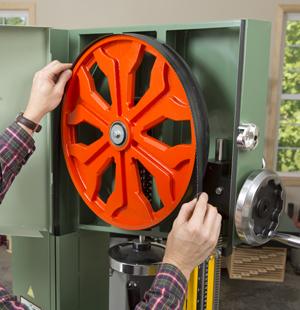
No one around here seems to be able to answer my biggest question about newer band saws, so I’m wondering if you can give me a logical answer. After reading and looking through numerous books, magazines, and catalogues, I find no explanation why or how they can list a saw as one size when it is not. If the saw is listed as 14″, it should be able to cut 14″ or 14+. The same with an 18″ or 24″. I would not buy a 1/2″ drill bit if it would only make a 3/8″ hole any more than I would buy 2″ screws if they were only 1-1/2″. Hope you can help me with this dilemma. – Lewis Kougher
Rob Johnstone: Band saw sizes are derived from the diameter of the wheels in the saw. So a 14-inch band saw will have wheels that are 14-inches in diameter. There is another measure that indicates how wide a board you can resaw. But that is a completely different consideration.
Tim Inman: Following from Rob’s answer regarding wheel size, you also need to allow for the frame of the saw, and some safety gear, which reduces the actual cutting depth of a band saw to a couple of inches less than the wheel diameter. There are some 3-wheeled saws around, which enables a deeper cut than the wheel diameter, but they are not popular due to the flexibility of the frame they come with. Wobbly.
Some things are sized logically, some are sized by custom. A 2-inch flathead screw is actually only 2-inches long. It is measured from the top of the flat head to the tip. A 2-inch roundhead screw is longer. It is measured from the bottom of the head to the tip of the screw. So, it is a little longer overall than 2-inches. A 2×4, on the other hand, is never actually 2-inches by 4-inches. Originally, the 2×4 was sized correctly when cut green from the log, and the drying shrink made the final product smaller. People tolerated this, so it became the custom to accept smaller than “advertised” 2X4 inches. Now, the standard allows for smaller lumber simply because they can get away with it. Every extra stud you get out of the log by shrinking the cut is an extra buck in somebody’s pocket. Thus, today’s 2×4 is only about 1-1/2 by 3-1/2. The band saw sizing system is a more honest designation!
Rod Burrow, RIKON Power Tools: Band saws are sized by both wheel diameter and throat depth (blade to column). However there is a guard on the column that protects the end user from the blade as it travels from the lower wheel to the upper wheel. The thickness of the guard is subtracted from the “size” of the saw resulting in the true throat depth.
Chris Marshall: Lewis, there are times when tool nomenclature only gets us so far. You’re probably frustrated by the fact that the frame column-to-blade distance on a band saw is SO close … and yet, not quite. On my 16-in. band saw, for instance, it’s 15-1/2 in. — not 16 — from the blade to the column. Here’s a novel idea: what if band saws were sold by the number that represents the blade length instead? Blade sizes are all over the board within the band saw industry. Even a single saw size often requires different blade lengths, depending on who makes the saw. If my saw were sold as a “145-in.”, at least I wouldn’t have to remember the blade length every time I need a new one. Now that would be handy.





